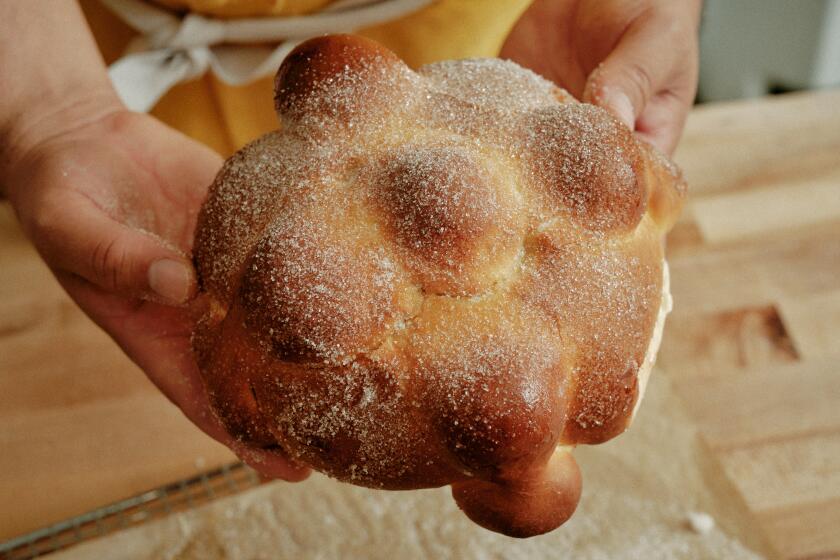Bauernkrapfen with powdered sugar

With a sly smile, like some mischievous 6-foot-7 Santa Claus, Austrian chef Bernhard Mairinger says he has just dropped off a strudel for L.A.’s best-known Austrian, Wolfgang Puck. Giving a gift of strudel is one of the holiday traditions he still clings to, even though it’s hard to imagine two places more different than Austria and Southern California.
After closing his modern Austrian bistro, BierBeisl, late last year with plans to relocate to the Westside, the barely 30-year-old chef has been free of his grueling day-to-day cooking schedule for the first time in years. Last Christmas, the hiatus allowed Mairinger to go back home for the holidays.
He loves the holidays, he says, and then he proceeds to list the things he enjoys most about celebrating at his village of Nussdorf am Attersee in upper Austria. Population: 1,000.
First of all, there’s snow. And starting the first week of December, little stands are set up outdoors to serve glühwein (warm, spiced wine) and roasted chestnuts. Usually, he says, you go with friends after church and meet at the glühwein stand. “It’s so good standing around in the snow drinking hot wine, which is spiced with sugar, cinnamon, cloves, allspice and apple. And roasted chestnuts? That’s my favorite way to eat them, just out of the shell.”
By mid-December, the outdoor Christmas markets, where you can buy hand-carved wooden animals and nativity figures, are going up. The biggest one in the region is in Salzburg. You drink more glühwein and also eat bauernkrapfen, warm pan-fried doughnuts dusted with powdered sugar or stuffed with jam. They’re made with a light brioche dough and don’t have a hole. “I could die for those. They’re amazing.”
In Austria, Christmas Eve is the big day, and the tradition is to have a lunch of bratwurst with boiled potatoes and onions. They’re not the usual pork-and-veal bratwurst; they’re special ones that are leaner than usual, made only with veal. It’s meant to be a light lunch, because the big holiday feast is that night, when everyone either eats out or eats at home with family.
For Christmas Eve, Mairinger likes to roast a duck or goose with braised red cabbage and the bread dumplings that function like an extra stuffing to soak up all that rich, redolent gravy. As a first course, he usually serves some kind of soup, especially pumpkin soup garnished with roasted pumpkin seeds and a special iridescent pumpkin seed oil. The best oils come from Styria in southern Austria, he says. “It takes 300 kilos of pumpkin seeds to make one liter of oil.”
In Austria, Christmas almost always involves snow. Here in Southern California, where Mairinger has lived for six years, he likes to have the same menu, even though it doesn’t get that cold.
Because who knows the next time he’ll get a chance to get back home. That long vacation is about to end when his more casual concept and bakery BierBeisl Imbiss opens downtown in the Spring Arcade at the end of February.
In a small bowl, combine the warm milk and yeast, stirring until the yeast is dissolved in the milk. Set aside until the yeast begins to bubble in the milk, several minutes.
In the bowl of a stand mixer, beat the eggs and sugar until smooth. Beat in the warm milk mixture, rum and melted butter. Slowly beat in half of the flour mixture, then beat in the salt. Beat in the remaining flour to form a smooth dough.
Remove the dough to a floured surface and knead until it is soft and somewhat silky (it’s a rich dough and may not be entirely smooth), 5 to 7 minutes; the dough should be very soft, but if it is too moist, slowly knead in additional flour. Place the dough in a large, oiled bowl and lightly cover with plastic wrap. Set aside in a warm place until doubled in size, about 1 hour.
On a lightly floured surface, divide the dough into 2-ounce pieces, rolling each into a ball. Loosely cover the balls and set aside until they have puffed and almost doubled in size, about 20 minutes.
While the balls are rising, heat oil in a large pot or deep fryer to 385 degrees. Flatten the dough balls into doughnut-like shapes; however, instead of poking a hole in the center, leave a very thin film of dough in the center (it will look like a very thin indentation in the center of each piece.
Fry until golden brown on each side, 2 to 3 minutes, and then place on paper towels to soak up any excess oil. Dust with powdered sugar and serve with apricot jam.
Get our Cooking newsletter.
Your roundup of inspiring recipes and kitchen tricks.
You may occasionally receive promotional content from the Los Angeles Times.















